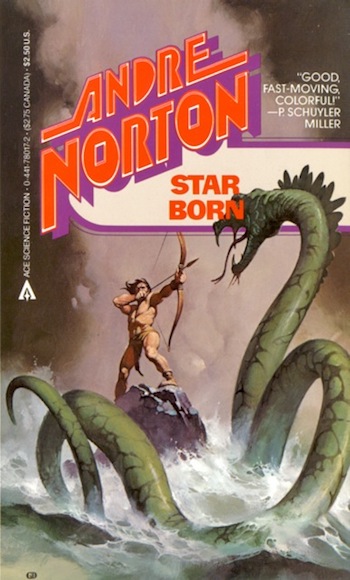I actually remember reading the beginning of Star Born, with the dark-skinned, fair-haired human and the furry alien named Sssuri in a boat. I don’t remember anything at all after that, but this book definitely came my way during my childhood library forays.
It’s a rarity for any author: a sequel that stands solidly on its own. It makes regular references to The Stars Are Ours! but the characters and story are distinct enough for a standalone.
Five hundred years have passed since rebel scientists fled the evil Pax in a hastily cobbled together spaceship. Three hundred of those years were spent in cold sleep, then the ship made a last-ditch landing on an earthlike planet which the colonists named Astra. That planet turned out to be occupied by at least two sentient species, one of which, the mermen, became the Terrans’ allies. The other, called Those Others, was just plain evil, and had nearly destroyed the planet before retreating to another continent.
Now, two centuries later, the Terrans have settled in to a fairly comfortable low-tech existence. And they’ve mutated. The mermen and the rabbitlike hoppers communicate telepathically. The Terrans’ own mind powers have grown with each generation, and they’ve changed a bit physically as well, becoming smaller and less heavily built than their ancestors.
The story begins with Dalgard Nordis and his knife-brother, Sssuri, venturing out on Dalgard’s “man-journey.” He’s an explorer and scout, and he’s on a mission to study and map one of Those Others’ abandoned cities.
In all the time the Terrans have been on the planet, they’ve made no attempt to confront Those Others across the ocean. Now however the world is about to change. Two things have happened: Those Others have sent a force to reclaim the city and strip it of its lost treasures. And a Terran ship has landed on Astra.
Back home on Terra, the Pax is dead. The rebels have won. People are conscientiously free, and they’re taking aim again at the stars. They’re testing an experimental hyperdrive, but the tests so far have not been successful.
This ship, the tenth to be sent out, has made it through with a small crew, all male of course. This is a nearly completely female-free book.
One of the Terrans is the pilot Raf Kurbi. It’s obvious that Dalgard and Raf are going to meet, but not until they’ve both had their own separate sets of exciting adventures. Dalgard gradually realizes that Those Others are back, and they’re slaughtering any living thing they come across. Raf’s crew meanwhile meet Those Others, and don’t realize what they’ve got themselves into. They’re naive and trusting, and they’re captivated by the aliens’ technology.
They do eventually find out the truth, but not before they’re taken across the ocean to Those Others’ decaying city. By that time Dalgard and Sssuri have been separated, and Dalgard is captured and taken to the city.
Buy the Book


The Future of Another Timeline
By this point Raf has figured out that the aliens are very bad people, and his captain is catching on as well. He goes out spying, and ends up rescuing Dalgard and a wounded elder of the mermen. With Those Others in pursuit, the three of them make a run for it.
The mermen are out to destroy their ancient enemies, and Raf just happens to have offworld weapons that can make a significant difference. He blows up the heart of Those Others’ surviving technology, rounds up the rest of his crew, and makes a run for the ship.
Dalgard has a chance to leave with the Terrans, but he makes a different choice. He convinces Raf that his people aren’t ready yet to meet their distant relatives. They’re still evolving, still developing their culture and their mind powers. They need time.
The two of them agree to keep Dalgard’s people a secret. Raf will tell the rest of his crew that the mermen helped him get away from the aliens; he won’t mention Dalgard. He leaves the planet, and Dalgard sets off for home—a long journey across the ocean, but it’s clear he’ll make it. Very little stops Dalgard when he sets out to do something.
There’s so much going on here. The plotting is deft, the strands smoothly interwoven, with two separate protagonists from two separate worlds, and two sets of missions and goals, with the millennia-old war between Those Others and the mermen in the middle.
The Terrans have emerged from the Pax with a deep revulsion against racial and religious prejudice. They try very hard to resist any temptation toward bias. And yet they fall into the trap of thinking that the human-like Others are like them, and that the furry, nonverbal (because telepathic) mermen are inferior animals. They don’t understand about mind powers, or really believe in them, until Raf is forced to. Raf is a sensitive (though he doesn’t know it till it happens), and is able to communicate with Dalgard, though not with the mermen.
Raf learns to distinguish between good aliens and bad aliens, and to understand that human shape doesn’t necessarily mean an alien thinks or acts or feels like a human. It’s a strong lesson for him, but the rest of his crew doesn’t quite get the full range of it. They take off without having accomplished a great deal apart from proving that their hyperdrive works, and having discovered an earthlike world in the process.
It’s not clear how soon they’ll be back, or where their space program will go from here. They don’t seem interested in colonizing so much as finding out what’s out there. Which is good actually, considering what colonialism can do to people and cultures.
Norton’s colonialism in general tends toward colonizing planets that aren’t already occupied by sentient species. The situation here is complicated—the original Terran ship basically crash-lands on a random planet selected by the ship’s programming. They stumble into the aftermath of a global war between uber-Nazis and the species they brutalized and enslaved, who now want to wipe their former masters off the face of the planet.
Dalgard has no qualms about that. Raf does, and nearly refuses to use his force grenades against Those Others, but in the end he gives in. He chooses to destroy a species that has no redeeming features, a species of random killers, of slavemasters and ruthless abusers. It’s evil. It deserves to die.
Here it seems Norton is confronting the dilemma of anti-prejudice. What if the other guy really is beyond redemption? Do you keep on trying to see his point of view? Or do you exterminate him before he can exterminate you?
As she has before, Norton develops these complex ideas within the framework of a fast-paced adventure. The ending of this one isn’t quite what you might expect. The intrepid scout opts to go home and not tell people about the Terrans. The equally intrepid pilot goes back to his ship and doesn’t tell anyone about the human colonists. It’s all about waiting and patience and not pushing things further than they’re ready to go.
It’s also about hope, and about how people and cultures evolve. And about friendship, too, and how people who are profoundly different from each other physically and culturally can still find things in common. (Or not, in the case of Those Others.)
Next time I’ll read Secret of the Lost Race. More Fifties space adventure. Another plucky loner against the universe.
Judith Tarr’s first novel, The Isle of Glass, appeared in 1985. Her most recent novel, Dragons in the Earth, a contemporary fantasy set in Arizona, was published by Book View Cafe. In between, she’s written historicals and historical fantasies and epic fantasies and space operas, some of which have been published as ebooks from Book View Café. She has won the Crawford Award, and been a finalist for the World Fantasy Award and the Locus Award. She lives in Arizona with an assortment of cats, a blue-eyed dog, and a herd of Lipizzan horses.











“a hastily cobbled together spaceship”
That’s an interesting concept, given how complex even a simple spaceship would be. Heck, a hastily cobbled together boat would more than likely sink quickly.
I was quite impressed by this book when I read it. This book is out of copyright, and it’s in the ANDRE NORTON MEGAPACK which should be in most library ebook collections.
The MEGAPACK is a huge ebook collection of Norton’s short stories and novels from 1947-62. The short stories are impossible to find elsewhere, but most of the novels have been reprinted individually. A really nice critical essay about Norton is included. Content: “The People of the Crater,” “The Gifts of Asti,” PLAGUE SHIP, STAR BORN, “All Cats Are Gray,” THE TIME TRADERS, VOODOO PLANET, STORM OVER WARLOCK, STAR HUNTER, THE DEFIANT AGENTS, KEY OUT OF TIME. HISTORICAL: RALESTONE LUCK, RIDE PROUD REBEL!, REBEL SPURS. MYSTERY: MURDER FOR SALE.
Another book that reminds me closely of this story is Iron Cage. I have to re-read it again but it may be set around this period as well. It has an interesting framing device geared at a younger audience.
@@@@@ 1, wiredog:
“a hastily cobbled together spaceship”
That’s an interesting concept, given how complex even a simple spaceship would be. Heck, a hastily cobbled together boat would more than likely sink quickly.
Into the 1950s, SF writers drastically underestimated the necessities of real world space exploration. I remember one story where the protagonist built a successful Mars rocket in his backyard.
Another example is Poul Anderson’s The Makeshift Rocket. Of course, that was asteroid to asteroid. No escaping Earth’s gravity-well required.
@1 As @6 says, at the time writers didn’t realize how complicated space travel really is. Norton in this book doesn’t mention the consequences of traveling for years in no gravity and then suddenly landing on a planet with Earthlike gravity. Her ships were always rockets with fins and no radiation shielding–her spacers all had “space tans.” Ships were metal tubes with some sort of oxygen generators, but no explanation for where the O2 would be coming from. Basically submarines in space. So yes, they could cobble a ship together and launch it without testing anything.
Those were far more innocent times.